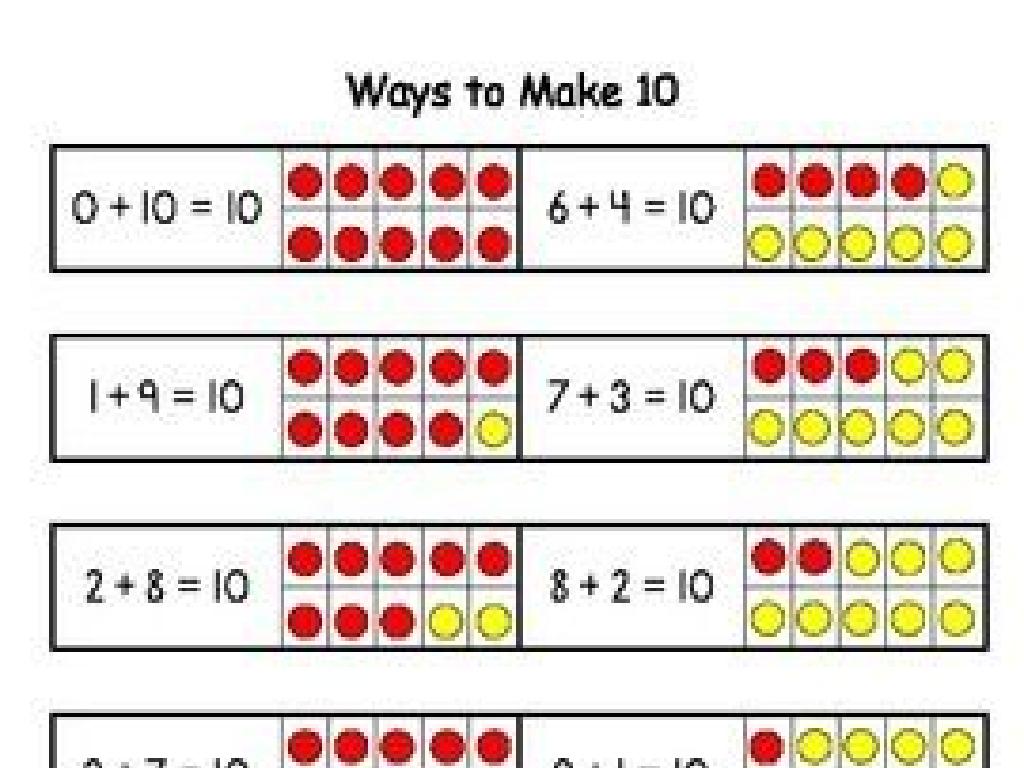Positive And Negative Square Roots
Subject: Math
Grade: Eighth grade
Topic: Square Roots And Cube Roots
Please LOG IN to download the presentation. Access is available to registered users only.
View More Content
Introduction to Square Roots
– What is a square root?
– The square root of a number is a value that, when multiplied by itself, gives the number.
– Positive vs. negative roots
– For any positive number, there are two square roots: one positive and one negative.
– Square roots in equations
– Square roots are often found in quadratic equations and can determine points on a graph.
– Real-world applications
– Used in architecture, engineering, and finance to calculate areas, sides of squares, and more.
|
This slide introduces the concept of square roots, which are fundamental in mathematics. A square root of a number is a value that produces the original number when multiplied by itself. It’s crucial to highlight that every positive number has both a positive and negative square root, known as principal and negative square roots, respectively. Understanding square roots is essential for solving quadratic equations, which is a key skill in algebra. Additionally, square roots have practical applications in various fields such as architecture, where they are used to calculate areas and dimensions, and in finance for certain types of calculations. Encourage students to think of square roots as a way to ‘undo’ squaring a number, and provide examples to illustrate their use in real-world scenarios.
Positive and Negative Square Roots
– Every number has two square roots
– Principal square root is positive
– The non-negative root of a number, e.g., 9 = 3
– Examples of positive roots
– 4 = 2, 16 = 4, 25 = 5
– Negative roots also exist
– For every positive root, there’s a negative counterpart, e.g., 9 = ±3
|
This slide introduces the concept of square roots, emphasizing that every positive number has two square roots: one positive (the principal square root) and one negative. Use examples to illustrate the principal square root, such as the square root of 4, which is 2. Highlight that while we often focus on the positive square root, the negative square root is equally valid and important in mathematics. Encourage students to think of square roots in pairs and to practice finding both roots for given numbers. This foundational understanding will be crucial as they progress in algebra and encounter equations where both roots may come into play.
Understanding Negative Square Roots
– Negative numbers and square roots
– Real numbers have no negative square roots
– Introducing imaginary numbers
– ‘i’ represents -1, leading to imaginary numbers
– Examples of negative square roots
– -4 is 2i, as -4 is 2^2 and i is -1
– Practical implications
|
This slide introduces the concept that negative numbers do not have real square roots, as squaring any real number results in a positive value. To address this, the concept of imaginary numbers is introduced, with ‘i’ representing the square root of -1. Provide examples such as the square root of -4, which is 2i, to illustrate how imaginary numbers work. Discuss the practical implications of this concept in fields like engineering and physics, where complex numbers are used. Encourage students to explore the idea further with additional examples and to understand the fundamental difference between real and imaginary numbers.
Calculating Square Roots
– Calculate roots without a calculator
– Use estimation and prime factorization
– Using calculators for square roots
– Learn calculator symbols and functions
– Practice with step-by-step solutions
– Solve example problems together in class
|
This slide aims to equip students with the skills to calculate square roots both manually and with the aid of a calculator. Begin by teaching estimation techniques and the process of prime factorization for finding square roots without a calculator. Then, demonstrate the use of a calculator for this purpose, familiarizing students with the necessary symbols and functions. Provide practice problems that we will solve together, offering step-by-step solutions to reinforce learning. Encourage students to try solving problems both ways to understand the concept thoroughly.
Square Roots in Geometry
– Area of squares via square roots
– To find the area, square the length of the side (s^2). For reverse, use the square root.
– Square roots in right triangles
– The hypotenuse is the square root of the sum of squares of the other two sides.
– Real-world geometry applications
– Use square roots to solve real-life problems, like calculating floor sizes.
– Understanding Pythagorean theorem
– a^2 + b^2 = c^2, where c is the hypotenuse of a right triangle.
|
This slide introduces students to the practical applications of square roots in geometry. Start by explaining how square roots are used to find the area of squares, highlighting the inverse relationship between squaring a number and finding its square root. Then, discuss the Pythagorean theorem and how square roots help find the length of the hypotenuse in right triangles. Provide real-world examples, such as determining the size of a TV screen or the flooring needed for a room, to illustrate these concepts. Encourage students to think of other examples where they can apply square roots in geometry. This will help solidify their understanding and show the relevance of square roots in everyday life.
Class Activity: Square Root Exploration
– Pair up and solve problems
– Find roots of perfect squares
– Perfect squares: 16, 25, 36…
– Find roots of non-perfect squares
– Non-perfect squares: 20, 34, 50…
– Present solutions to the class
|
This activity is designed to encourage collaborative learning and practice in finding both positive and negative square roots. Students should pair up to work through a set of problems that include both perfect squares (e.g., 4, 9, 16) and non-perfect squares (e.g., 5, 10, 15). They should use estimation and other strategies to find the square roots of non-perfect squares. After solving the problems, each pair will present their solutions and the methods they used to the class. This will help students learn from each other and understand different approaches to solving square roots. Possible activities: 1) Estimating square roots on a number line, 2) Using a calculator to find square roots, 3) Squaring numbers to find perfect squares, 4) Creating a square root spiral.
Wrapping Up: Positive & Negative Square Roots
– Recap: Positive & Negative Roots
– Remember, a^2 = a and (-a)^2 = -a
– Why Square Roots Matter
– Essential for algebra, geometry, and beyond
– Homework: Practice Worksheet
– Complete the worksheet on both root types
|
As we conclude today’s lesson, it’s important to reinforce the concept of both positive and negative square roots. Understanding that every positive number has two square roots, one positive and one negative, is crucial for solving quadratic equations and other higher-level math problems. Emphasize the practical applications in various fields of science and engineering. For homework, students are assigned a worksheet that includes problems on identifying and working with both positive and negative square roots. This will help solidify their understanding and prepare them for more complex mathematical concepts. Encourage students to attempt all problems and remind them that practice is key to mastery.






